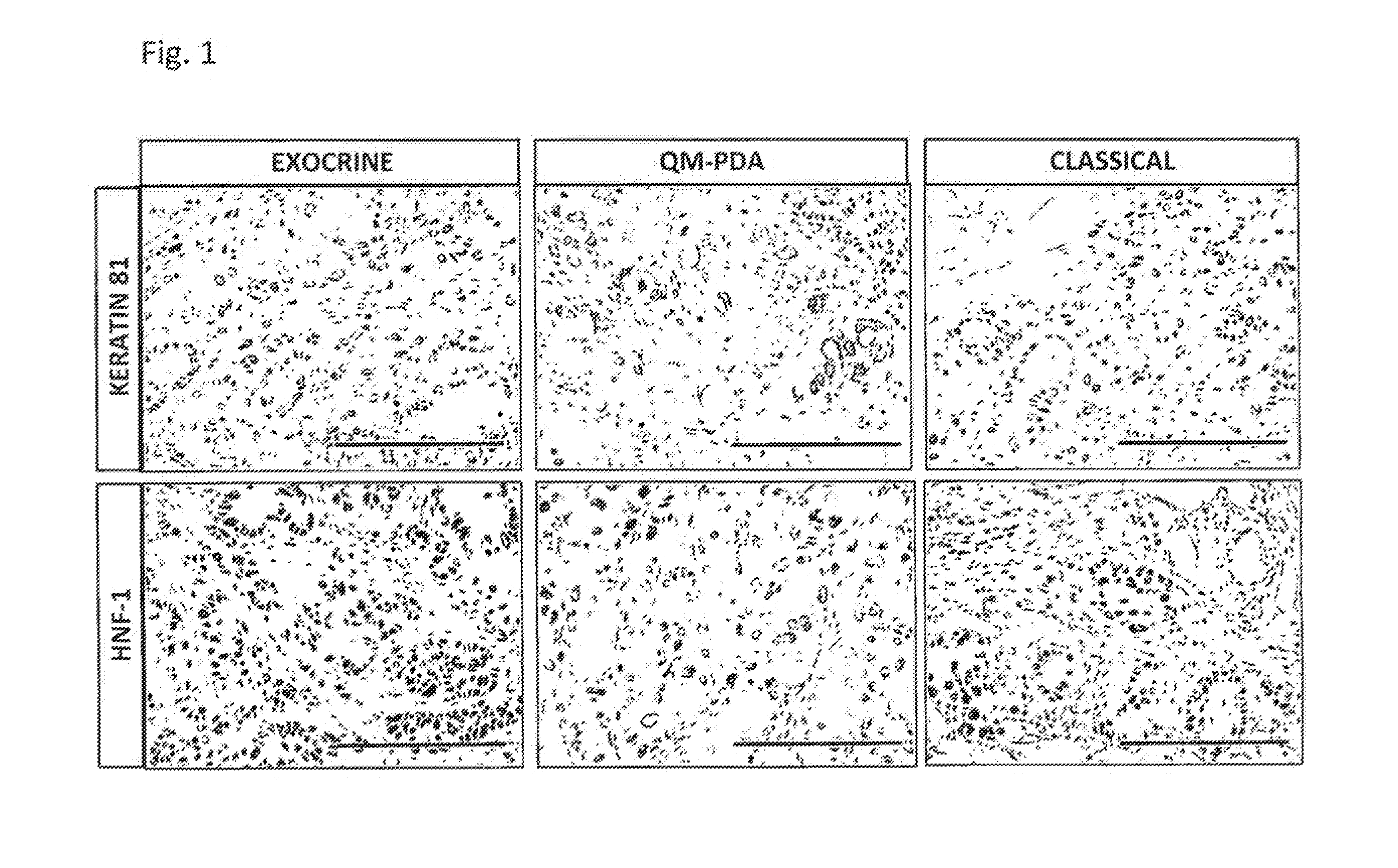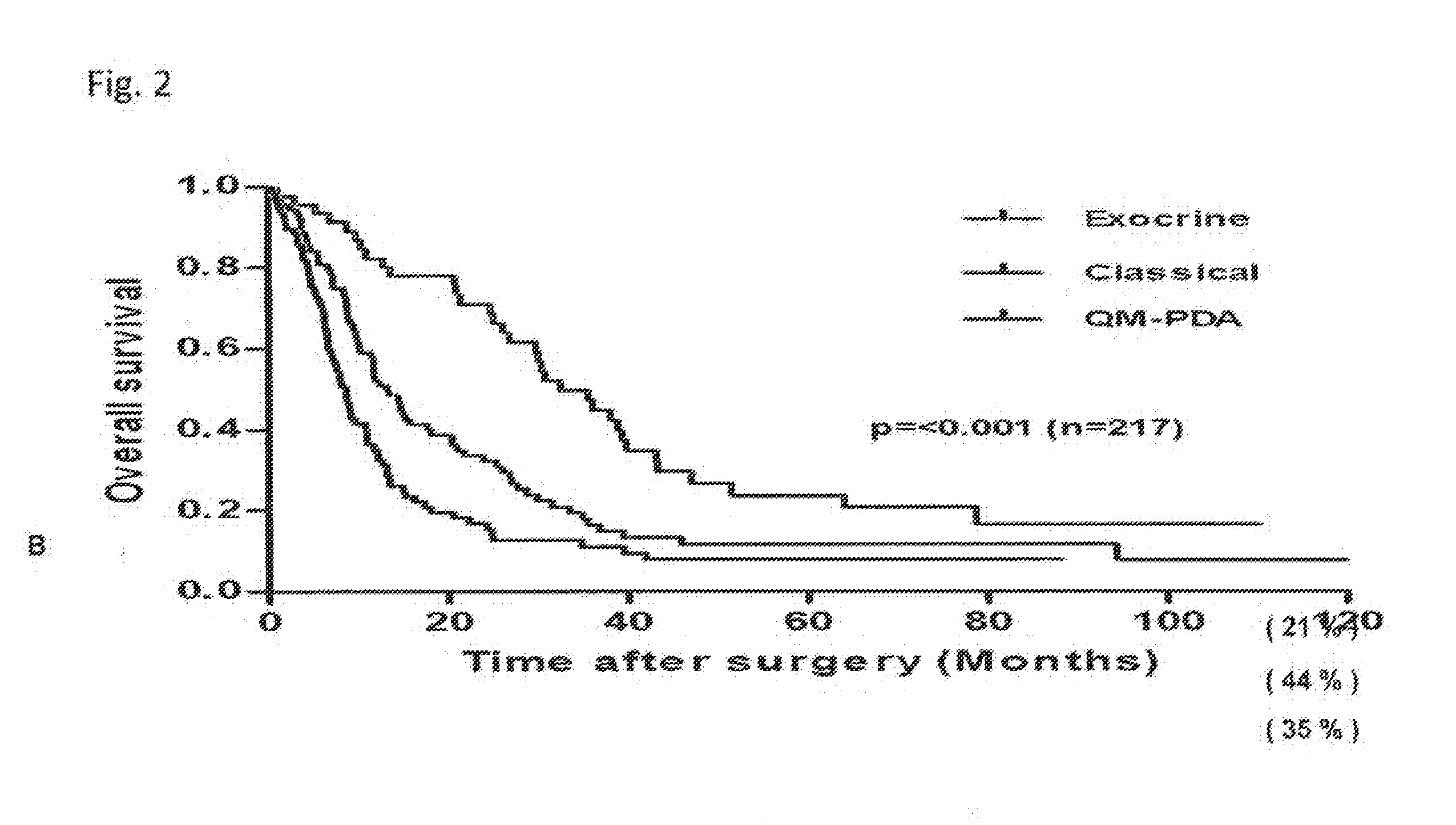Novel biomarkers for sub-typing pancreatic ductal adenocarcinoma
a pancreatic ductal adenocarcinoma and biomarker technology, applied in the field of new subtype specific markers of pancreatic ductal adenocarcinoma, can solve the problems of limited or no benefit of recent trials of targeted therapies, and achieve the effect of reliable and accurate attribution of pdac specimens and improved prognostic evaluation
- Summary
- Abstract
- Description
- Claims
- Application Information
AI Technical Summary
Benefits of technology
Problems solved by technology
Method used
Image
Examples
example 1
Identification of PDAC Subtype-Specific Markers
[0081]Subtype-specific gene expression analysis was performed using primary xenografts, proprietary stable PDAC cell lines that retain the gene-expression pattern associated with the original tumor subtype and thus allow for molecular characterization of the classical, quasi-mesenchymal, and exocrine-like PDAC subtype for the identification of subtype-specific biomarkers, and cell line-derived tumors. Genes showing strong (>5 fold) differential subtype-specific expression in the gene expression analysis were included in the screen for subtype-specific marker proteins. Since immunohistochemical markers are most useful for clinical settings, this initial candidate list was refined using the Protein Atlas database. In addition a search for subtype-specific expression of transcription factors using the GSEA motif module was carried out. This revealed an enrichment of genes containing binding sites for the transcription factor HNF-1 exclusiv...
example 2
Prediction of Src-Inhibitor Sensitivity Using mRNA Expression
[0083]Total RNA was isolated from PDAC cell lines or tumor xenografts using the miRNAeasy kit (Qiagen, Hilden). Gene expression analysis was performed with the Illumina BeadChip Technology (HumanHT-12). The resulting normalized gene list for each sample was sorted according to the detected signal. Genes with the highest signal were at the top and the rest sorted in descending order. This ranked gene list was used as input for the GSEA-Algorithm (Subramanian et al., loc. cit.). Each ranked list was compared separately against the sensitivity predictor signature (SRC-SP) described in Table 1, and the FDR calculated. A FDR cut-off value of 0.200 was determined to be optimal for accurate classification of samples into either Src-inhibitor sensitive or resistant. Samples resulting in a FDR0.200 predicts resistance.
example 3
Identification of HNF-1 Target Genes Overexpressed in the Exocrine-Like Subtype
[0084]We identified target genes of the transcription factor HNF-1A that are overexpressed in the exocrine-like subtype. These genes could be used as further markers for the exocrine-like subtype.
[0085]Total RNA was isolated from different PACO lines at early passage and late passage (80% confluent) or tumor tissue (30 mg) using the miRNeasy kit (Qiagen, Hilden). Gene expression analysis was performed using the Illumina BeadChip Technology (HumanHT-12v4). For analysis of differential gene expression and clustering the TM4 Microarray Software Suite was employed (Saeed, A. I., Sharov, V., White, J., Li, J., Liang, W., Bhagabati, N., Braisted, J., Klapa, M., Currier, T., Thiagarajan, M., et al. (2003). TM4: a free, open-source system for microarray data management and analysis. BioTechniques 34, 374-378). Gene set enrichment analysis on normalized data was conducted as described previously (Subramanian et al...
PUM
| Property | Measurement | Unit |
|---|---|---|
| pH | aaaaa | aaaaa |
| diameter | aaaaa | aaaaa |
| nuclear size | aaaaa | aaaaa |
Abstract
Description
Claims
Application Information
 Login to View More
Login to View More - R&D
- Intellectual Property
- Life Sciences
- Materials
- Tech Scout
- Unparalleled Data Quality
- Higher Quality Content
- 60% Fewer Hallucinations
Browse by: Latest US Patents, China's latest patents, Technical Efficacy Thesaurus, Application Domain, Technology Topic, Popular Technical Reports.
© 2025 PatSnap. All rights reserved.Legal|Privacy policy|Modern Slavery Act Transparency Statement|Sitemap|About US| Contact US: help@patsnap.com



